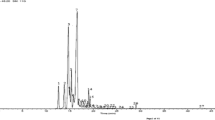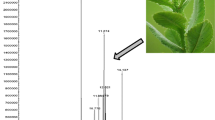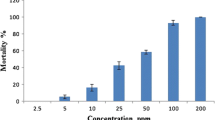Abstracts
The present study deals with investigation of larvicidal activity and their chemical constituents of the essential oil from the seeds of Nigella sativa L. (Ranunculaceae). Totally, 18 chemical compounds were identified by GC and GC-MS analysis. Thymol (19.13 %) and α-phellandrene (14.9 %) were identified as major chemical components followed by camphor (12.14 %), borneol (11.31 %), and carvacrol (8.65 %). The larval mortality was observed after 12 and 24 h of exposure period. The results revealed that the essential oil were evaluated against the fourth instar larvae of Aedes aegypti, Anopheles stephensi, and Culex quinquefasciatus. After 12 h of exposure period, the larvicidal activities were LC50 = 196.9 and LC90 = 523.5 ppm (A. aegypti), LC50 = 88.1 and LC90 = 272.4 ppm (A.stephensi), and LC50 = 241.6 and LC90 = 545.4 ppm (C. quinquefasciatus), and the larvicidal activities after 24 h of exposure period were LC50 = 99.9 and LC90 = 300.8 ppm (A. aegypti), LC50 = 53.9 and LC90 = 172.6 ppm (A. stephensi), and LC50 = 141.7 and LC90 = 364.0 ppm (C. quinquefasciatus). The results of the present study showed that the essential oil from seeds of N. sativa is inexpensive food formulation and new source of natural larvicidal agent.

Similar content being viewed by others
References
Aboul-Ela EI (2002) Cytogenetic studies on Nigella sativa seeds extract and thymoquinone on mouse cells infected with schistosomiasis using karyotyping. Mutation Res 516:11–17
Ali BH, Blunden G (2003) Pharmacological and toxicological properties of Nigella sativa. Phytother Res 17(4):299–305
Aljabre SHM, Randhawa MA, Akhtar N, Alakloby OM, Alqurashi AM, Aldossary A (2005) Antidermatophyte activity of ether extract of Nigella sativa and its active principle, thymoquinone. J Ethnopharmacol 101:116–119
Amer A, Mehlhorn H (2006) Larvicidal effects of varies essential oils against Aedes, Anopheles, and Culex larvae (Diptera, Culicidae). Parasitol Res 99:466–472. doi:10.1007/s00436-006-0182-3
Bossche V, Coetzer JA (2008) Climate change and animal health in Africa. Rev Sci Tech 27:551–562
Burits M, Bucar F (2000) Antioxidant activity of Nigella sativa essential oil. Phytotherapy Res 14:323–328
Cheng SS, Chang HT, Chang ST, Tsai KH, Chen WJ (2003) Bioactivity of selected plant essential oils against the yellow fever mosquito Aedes aegypti larvae. Bioresource Technol 89:99–102
Cheng SS, Liu JY, Tsai KH, Chen WJ, Chang ST (2004) Chemical composition and mosquito larvicidal activity of essential oils from leaves of different Cinnamomum osmophloeum provenances. J Agricul Food Chem 52:4395–4400
Cheng SS, Chua MT, Chang EH, Huang CG, Chen WJ, Chang ST (2009) Variations in insecticidal activity and chemical compositions of leaf essential oils from Cryptomeria japonica at different ages. Bioresource Technol 100:465–470
Chio EH, Yang EC (2008) A bioassay for natural insect repellents. J Asia Pac Entomol 11:225–227
Dua VK, Pandey AC, Dash AP (2010) Adulticidal activity of essential oil of Lantana camara leaves against mosquitoes. Indian J Med Res 131:434–439
Elbanna MS (2006) Larvicidal effects of eucalyptus extract on the larvae of Culex pipiens mosquito. Int J Agr Biol 8:896–897
Gbolade AA, Oyedele AO, Sosan MB, Adewayin FB, Soyela OL (2000) Mosquito repellent activities of essential oils from two Nigerian Ocimum species. J Trop Med Plants 1:146–148
Govindarajan M, Sivakumar R, Rajeswari M, Yogalakshmi K (2012) Chemical composition and larvicidal activity of essential oil from Mentha spicata (Linn.) against three mosquito species. Parasitol Res 110:2023–2032
Howard AFB, Zhou G, Omlin FX (2007) Malaria mosquito control using edible fish in western Kenya: preliminary findings of a controlled study. BMC Public Health 7:199–204
Karunamoorthi K (2011) Vector control: a cornerstone in the malaria elimination campaign. Clin Microbiol Infect 17:1608–1616
Karunamoorthi K, Ilango K, Murugan K (2010) Laboratory evaluation of traditionally used plant-based insect repellents against the malaria vector Anopheles arabiensis Patton. Parasitol Res 106:1217–1223
Klempner MS, Unnasch TR, Hu LT (2007) Taking a bite out of vector-transmitted infectious diseases. The New England J Med 356:2567–2569
Knio KM, Usta J, Dagher S, Zournajian H, Kreydiyyeh S (2008) Larvicidal activity of essential oils extracted from commonly used herbs in Lebanon against the seaside mosquito, Ochlerotatus caspius. Bioresource Technol 99:763–768
Ko¨ kdil G, Yilmaz H (2005) Analysis of the fixed oils of the genus Nigella L.(Ranunculaceae) in Turkey. Biochem Systemat Ecolo 33:1203–1209
Krishnamoorthy S, Chandrasekaran M, Adaikala Raj G, Jayaraman M, Venkatesalu V (2015) Identification of chemical constituents and larvicidal activity of essential oil from Murraya exotica L. (Rutaceae) against Aedes aegypti, Anopheles stephensi and Culex quinquefasciatus (Diptera: Culicidae) 114: 1839–1845. doi: 10.1007/s00436-015-4370
Makhaik M, Naik SN, Tewary DK (2005) Evaluation of anti-mosquito properties of essential oils. J Sci Ind Res 64:129–133
Moretti A, D’Antuono LF, Elementi S (2004) Essential oil of Nigella sativa L. and Nigella damascene L. seed. J Essent Oil Res 16:182–183
Nauen R (2007) Insecticide resistance in disease e vectors of public health importance. Pest Manag Sci 63(7):628–33
Nickavar B, Mojab F, Javidnia K, Amoli MAR (2003) Chemical composition of the fixed and volatile oils of Nigella sativa L. from Iran. Z Naturforsch 58:629–631
Prabhu K, Murugan K, Nareshkumar A, Ramasubramanian N, Bragadeeswaran S (2011) Larvicidal and repellent potential of Moringa oleifera against malarial vector, Anopheles stephensi Liston (Insecta: Diptera: Culicidae). Asian Pac J Trop Biomed 2:124–129
Rajkumar S, Jebanesan A (2005) Larvicidal and adult emergence inhibition effect of Centella asiatica Brahmi (Umbelliferae) against mosquito Culex quinquefasciatus Say (Diptera: Culicidae). Afr J Biomed Res 8:31–33
Ramadan MF (2007) Nutritional value, functional properties and nutraceutical applications of black cumin (Nigella sativa L.): an overview. Int J Food Sci Tech 42:1208–1218
Ramadan MF, Asker MMS, Tadros M (2012) Antiradical and antimicrobial properties of cold-pressed black cumin and cumin oils. Eur Food Res Technol 234:833–844
Revay EE, Junnila A, Xue RD, Kline DL, Bernier UR, Kravchenko VD (2012) Evaluation of commercial products for personal protection against mosquitoes. Acta Trop 125(2):226–230
Runyoro D, Ngassapa O, Vagionas K, Aligiannis N, Graikou K, Chinou I (2010) Chemical composition and antimicrobial activity of the essential oils of four Ocimum species growing in Tanzania. Food Chem 119:311–316
Sagar SK, Schgal S (1997) Toxicity of neem seed coat extract against mosquitoes. Indian J Entomol 59:215–233
Sagar SK, Sehgal SS (1996) Effects of aqueous extract of deoiled neem (Azadirachta indica A. Juss) seed kernel and karanja (Pongamia glabra Vent) seed kernel against Culex quinquefasciatus. J Commun Disord 28:260–269
Sakulku U, Nuchuchua O, Uawongyart N, Puttipipatkhachorn S, Soottitantawat A, Ruktanonchai U (2009) Characterization and mosquito repellent activity of citronella oil nanoemulsion. Int J Pharmaceut 372:105–111
Salem ML (2005) Immunomodulatory and therapeutic properties of the Nigella sativa L. seed. Int Immunopharmacol 5:1749–1770
Salem ML, Hossain MS (2000) Protective effect of black seed oil from Nigella sativa against murine cytomegalovirus infection. Inter J Immunopharmacol 22(9):729–740. doi:10.1016/S0192-0561(00)00036-9
Senthilkumar A, Jayaraman M, Venkatesalu V (2013) Chemical constituents and larvicidal potential of Feronia limonia leaf essential oil against Anopheles stephensi, Aedes aegypti and Culex quinquefasciatus. Parasitol Res 112:1337–1342
Senthilkumar A, Venkatesalu V (2012) Larvicidal potential of Acorus calamus L. essential oil against filarial vector mosquito Culex quinquefasciatus (Diptera:Culicidae). Asian Pac J Trop Dis 4:324–326
Senthilkumar N, Verma P, Gurusubamanian G (2009) Larvicidal and adulticidal activities of some medicinal plants against the malarial vector Anopheles stephensi (Liston). Parasitol Res 104:237–244. doi:10.1007/s00436-008-1180-4
Singh G, Marimuthu P, de Heluani CS, Catalan C (2005) Chemical constituents and antimicrobial and antioxidant potentials of essential oil and acetone extract of Nigella sativa seeds. J Sci Food Agr 85:2297–2306
Traboulsi A, El-Haj S, Tueni M, Taoubi K, Nader NB, Mrad A (2005) Repellency and toxicity of aromatic plant extracts against the mosquito Culex pipiens molestus (Diptera: Culicidae). Pest Manage Sci 61:597–604
Traboulsi AF, Taoubi K, El-Haj S, Bessiere JM, Rammal S (2002) Insecticidal properties of essential plant oils against the mosquito Culex pipiens molestus (Diptera: Culicidae). Pest Management Sci 58:491–5
Vincent I (2000) Cycling to the finish. Neurobiol Aging 21:757–760
Wajs A, Bonikowski R, Kalemba D (2008) Composition of essential oil from seeds of Nigella sativa L. cultivated in Poland. Flavour Fragr J 23:126–132
World Health Organization (1981) Instruction for determining the susceptibility or resistance of mosquito larvae to insecticides. WHO-VBC 81(807):1–6
World Health Organization (2012) Dengue and severe dengue. Factsheet No. 117. WHO, Geneva
Worthen D, Ghoshan D, Crooks P (1998) The in vitro anti-tumor activity of some crude and purified components of blackseeds, Nigella sativa. J Anti-Cancer 18:1527–1532
Zaoui A, Cherrah Y, Alaoui K, Mahassine N, Amarouch H, Hassar M (2002) Effects of Nigella sativa fixed oil on blood homeostasis in rat. J Ethnopharmacol 79:23–26
Acknowledgments
The authors are thankful to Dr. K. Arumugam, Professor and Head, Department of Botany, Annamalai University for providing laboratory facilities for the study. We are thankful to The Director, Center for Research in Medical Entomology (ICMR—Government of India), Madurai, for mosquito egg supply.
Author information
Authors and Affiliations
Corresponding author
Rights and permissions
About this article
Cite this article
Raj, G.A., Chandrasekaran, M., Krishnamoorthy, S. et al. Phytochemical profile and larvicidal properties of seed essential oil from Nigella sativa L. (Ranunculaceae), against Aedes aegypti, Anopheles stephensi, and Culex quinquefasciatus (Diptera: Culicidae). Parasitol Res 114, 3385–3391 (2015). https://doi.org/10.1007/s00436-015-4563-3
Received:
Accepted:
Published:
Issue Date:
DOI: https://doi.org/10.1007/s00436-015-4563-3




